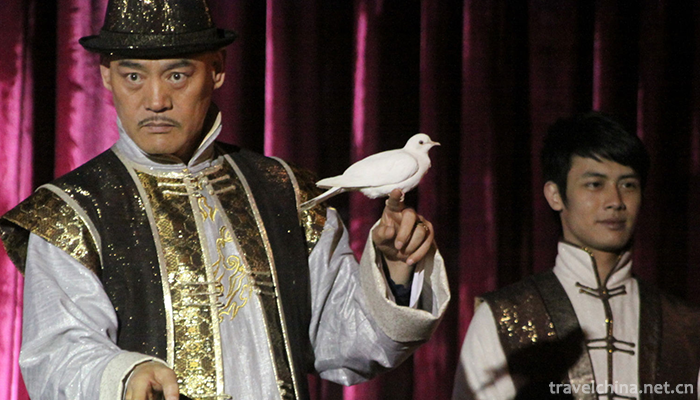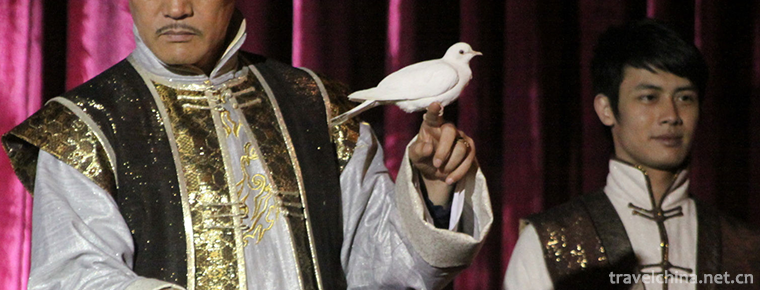conjuring tricks
conjuring;tricks
Conjuring tricks is one of the traditional Chinese acrobatics. Performers use agile methods to create audiovisual illusions, performing various objects, animals or water and fire and other rapid increase or decrease of hidden changes. China has a long history of juggling. According to Zhang Heng's "Xijing Fu" of the Han Dynasty, there were programs such as swallowing knives, spitting fire and painting ground into Sichuan as far back as the Han Dynasty.
Most of the props for tricks are daily necessities or production tools commonly used by the working people, such as pots, bowls, dishes, spoons, cages, boxes, cabinets, knives, etc.
On May 23, 2011, juggling was approved by the State Council to be included in the third batch of national intangible cultural heritage list.
Development
For thousands of years in ancient China, juggling has been a lasting folk art and a reflection of traditional Chinese culture.
Before the Qing Dynasty, artists performed in ancient costumes. In the Qing Dynasty, the performance of ancient costumes was banned by the Qing government. Since then, artists have been accustomed to wearing new long gowns and coats to perform. The costumes of jugglers follow this tradition, so artists who can see in modern times have been wearing coats to perform.
Prop
Most of the props of Chinese traditional tricks are daily necessities or production tools, such as pots, bowls, dishes, spoons, cages, boxes, cabinets, knives, etc.
technique
The trick is to "turn up and down, through diplomatic representation", which means that the gesture of handing over to the audience before the performance must be bright up, down, reverse and positive, and let the audience see Gabriel outside.
Colorful living
There are four sets of basic hand color work (i.e. hand skills) for "jugglers".
The trick is "Dan, sword, bean, ring". Dan is to swallow iron eggs, swords, swords, swords; beans, beans, beans picked by immortals (two bowls tied together seven gum beans, changing back and forth, no trace, no shadow in and out); rings, refers to nine continuous rings, the lead wire into nine iron rings, can be imagined as visible things, such as tricycles, official hats, flower baskets, lanterns and so on.
Distinguish
Modern so-called "magic" performance programs are mostly Western skills, belonging to foreign products, so the costumes of actors are suits or uniforms. Modern magic props originating in the West are unfamiliar to most audiences and are usually made of special features, such as magic sticks, magic guns, tin janes, magic vats, etc. The magic trick is "pull up with the upper finger and pull down with the left and right hand". When the actor lifts his finger upward and takes the opportunity to pull out the underlying things with the other hand, he calls it "pull down with the upper finger". When the actor shows the audience his left hand, he quickly pulls out the ambush with the right hand, which is called "pull up with the left and right hand".


-
1.Ruoergai CountyZoige County
Zoige County is located in the northeastern edge of the Qinghai-Tibet Plateau
Time 2018-10-12 -
2.Old Beijing fried Morchella
The most famous famous food in Beijing is old Beijing tripe and Beijing roast duck. As for the oldest and most prosperous snacks in Beijing, belly burst is definitely the best among them.
Time 2018-10-27 -
3.Benxi Water Tunnel Scenic Area
Benxi Water Cave, National AAAAA Class Tourist Scenic Spot, National Key Scenic Spot and Asian Member Unit of International Tourist Cave Association
Time 2018-12-04 -
4.Xixi National Wetland Park
Xixi National Wetland Park is located in the west of Hangzhou City, Zhejiang Province. It is only 6 kilometers away from Wulin Gate, the main city of Hangzhou, and 5 kilometers away from West Lake.
Time 2018-12-07 -
5.Lantern Dance
Lantern dance is a Chinese folk dance with a long history. It has been performed mainly on Lantern Festival for at least 1,000 years. Lantern dance originated from Lantern Festival and its production
Time 2019-04-26 -
6.Manchu Folk Stories
Liaoning is a region where Manchu people have formed, risen and grown up. It contains extensive and profound Manchu cultural relics and connotations. Manchu folktales originated from the Manchu people
Time 2019-05-18 -
7.Qin opera
Qin Opera, also known as Bangzi Opera, is a traditional drama in Northwest China and one of the national intangible cultural heritage.
Time 2019-06-10 -
8.Prince Wuwuwu quarrel
Prince Wujiaozi is one of the unique traditional folk dances in Beijing. It integrates entertainment, fitness and performance. Wujiaozi has a strong style, rough style, relaxation and generosity. Part
Time 2019-06-18 -
9.Chord cavity
Based on Pingli dialect in Ankang City, Shaanxi Province, there are 13 singing patterns, including 8 commonly used tunes, 18 suona tunes and 30 gongs and drums. Pingli string is a complete set of loca
Time 2019-07-03 -
10.Xinchang tune
Xinchang tune is one of the ancient opera tunes, also known as "falling out of tune", "Shaoxing high-key" and "Xinchang high-key". With Xinchang as the center, it has spr
Time 2019-07-06 -
11.Xujiaquan
Xujiaquan, a traditional boxing method, originated in Tongji Village, Xintai City, Shandong Province. Xujiaquan originated in Yongzheng Period of Qing Dynasty and was created by Xu Shengcai, Gaozu of
Time 2019-07-09 -
12.Gongga Mountain
Gongga Shan, also known as Minya Konka, is located in the south of Kangding, Sichuan Province. It is the main peak of Daxue mountain. There are 45 peaks with an altitude of more than 6000 meters.
Time 2020-10-13